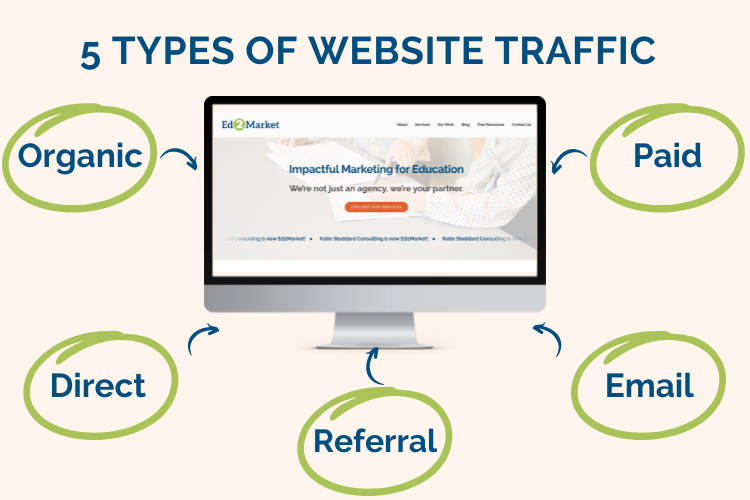Five Types of Website Traffic: What Do They Mean and How Do I Use Them?
So, you just spent hours crafting the perfect website and now you want to reach a broader audience. Maybe you try a Google search for “fastest ways to increase site traffic,” only to drown in thousands of search results. What do you do? If you’re unsure, don’t worry – you’re not alone. Since there are multiple ways to grow website traffic, it can be confusing to differentiate what each type is and how they can be used to your advantage. Read on for a description of each type of website traffic and quick ways to increase them so you can we explain the various types of website traffic so you can decide which are best aligned with your needs!
1. Organic Traffic
Perhaps the lowest-maintenance website traffic of all is organic. Organic traffic is always free because someone happened upon your website by using a search engine, such as Google or Bing. You can optimize your content to help direct traffic to your website when users get their results from search engines. Using tools like keywords and taglines that describe your business will ultimately help with “SEO” or Search Engine Optimization. Integrating educational keywords into your website will increase your website’s trustworthiness. Utilizing SEO is a critically important tool to ensure that your website is more visible when competing with others to be at the top of the Google search results!
2. Direct Traffic
While direct traffic and organic traffic may sound similar, they are actually quite different. As an education company, this is a process of continually working on getting your name out in the industry. Direct traffic bypasses a search engine altogether. Instead, users have to type your website’s URL into their browser for the traffic to be considered “direct.” Maybe they heard about your website from a friend or saw it on a flyer. A big percentage of direct traffic also comes from repeat website visitors, as they are likely using their search bar or bookmark to get to your site following their initial visit. These are the audience members who want to get to you and know exactly how to get there!
3. Referral Traffic
If you’ve ever clicked on an embedded link in a blog post, you were likely sent to another site–you were “referred” to that new site. Referral traffic results from your URL being linked from a separate source and is usually able to be tracked from that source. There are many ways for traffic to become referral traffic, such as you adding your website link in your email signature, your website is linked in a blog post, or maybe you added the link to your social media channels. Consistently posting content directed toward your website will help to drive traffic. Having a high volume of referral traffic can also help with SEO!
4. Email Traffic
Email traffic is the most straightforward type of website traffic. Email traffic is strictly generated through, you guessed it, email campaigns! This type of traffic is tracked using a CRM or marketing automation tool like Hubspot or MailChimp, and can help you see how many users are clicking through to your site using a link you provided in the copy of your email campaign. The best part about email traffic is that it will still count even if your email is from a month or two ago. As long as the URL stays the same, you will still accumulate traffic from your past email campaigns! What better way to offer educators freebies such as blogs, curriculum tips, videos, and more that they can store in their inbox and return to when needed.
5. Paid Traffic
Finally, there’s paid traffic. Paid traffic can be generated through various platforms, including popular social media channels such as Instagram, Twitter, Facebook, LinkedIn, and TikTok. If we know one thing, it’s that educators love the sense of community they can find on social media. This type of traffic can only occur if you’ve set up paid ads on each platform, which requires a few things. You will have to choose or design strong content for the ad, identify the number of viewers you want to reach, and set a budget. Paid traffic operates on a cost-per-click basis, meaning that you are charged only when a visitor clicks on your ad, which will then link them to your website. This is arguably the traffic type you have the most control over, seeing as you set everything up before the ads go live and can cease their operation at any time.
Feeling Stuck in Traffic?
Google Analytics is a great tool to monitor and analyze the traffic coming to your website. If you don’t have it set up, check out this user guide to get started. Or, contact us today and we can help.
We’re here to put you on the expressway to success! Ed2Market is your partner in launching your education service or product’s marketing strategy and helping you reach your goals!

